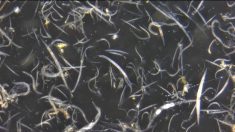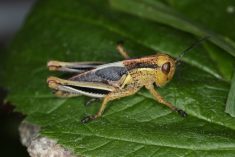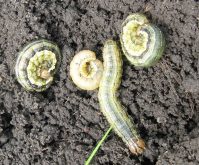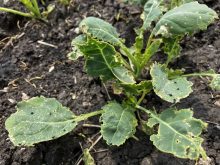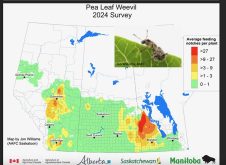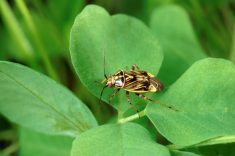Agriculture and Agri-Food Canada (AAFC) is asking farmers to keep an eye out for feeding damage and “shiny, slug-like creatures” on cereals, potential markers of cereal leaf beetle larvae.
“We need samples to monitor the biocontrol insect that kills this pest,” said Dr. Haley Catton.
If found, AAFC is asking farmers to send them samples of 10 to 30 larvae from affected fields, it said in a posting on June 7.
Read Also

Manitoba sclerotinia picture mixed for 2025
Variations in weather and crop development in this year’s Manitoba canola fields make blanket sclerotinia outlooks hard to pin down
The cereal leaf beetle made its first appearance in Manitoba in 2009 and spread from west to east explained provincial entomologist John Gavloski in a Co-operator report last August.
They’re most destructive in larvae form in which they strip upper tissue off leaves of cereals, forage grasses and some grassy weeds. They leave what appear to be long, white streaks.
Adult beetles feed between the veins of cereal plants and make long incisions.
The larvae protect themselves from predators by covering themselves with their own feces, called “fecal shields.”
To date, cereal leaf beetles have been noticeable on some Manitoban fields but have not reached economic levels Gavoloski said on June 18. This year they’ve been worst in eastern Manitoba.

The “biocontrol insect” referenced is a parasitic wasp which attack only cereal leaf beetles.
“It has established well, and we are seeing some high levels of parasitism,” Gavloski said.
AAFC asks farmers who find the larvae to take samples of 10 to 30 larvae from each affected field and package them separate, by field, in an air-tight vial with alcohol. Label them with your name, date, crop type and location, and send them to AAFC. Contact AAFC for details on how to ship them for free.
Since farmers probably may not have the right type of alcohol for preservation, said Gavloski, they can also contact him and he or summer students can come collect a sample.
Contact Haley Catton (AAFC) at [email protected] or 1-403-360-4248. Contact John Gavloski (MARD) at 1-204-750-0594.








